Page 1 | Page 2 | Page 3
Watch a series of videos with interviews about Beatrice Wood
featuring scholars and close friends of Beatrice Wood:

About Beatrice Wood
Beatrice Wood was an important contemporary artist, craftperson and writer. Her life ran the course of the 20th century and included many of the figures that shaped it. Ultimately, her genius was in the marriage of wide-ranging influences in her work. The spirit of Dadaism, impact of Modernism, embrace of Eastern philosophy, influence of folk art and even the ornament of ethnic jewelry were all combined in her ceramics. Her work reveals a mastery of form, combined with a preference for the naïveté of folk art. Ultimately, it is impossible to separate her life experiences from the work she created, as she truly mastered the art of a life. |
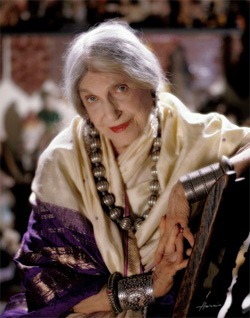
Beatrice Wood |
Becoming Beato
Beatrice Wood was born in 1893 in San Francisco to wealthy, socially conscious parents. Five years later, the family moved to New York City, where her mother concerned herself with preparing her daughter for her eventual “coming out” into New York society. This included a year in a convent in Paris, enrollment in a fashionable finishing school and summer trips to Europe, where she was exposed to art galleries, museums and the theatre. |

Beatrice Wood, Age 9
in Photographer's Studio, Paris
|
Ultimately, it was this exposure to the arts that ruined her mother’s plans for her. In 1912, Beatrice rejected plans for a coming-out party and announced that she wanted to be a painter. Her mother decided that, if this were the case, it would be accomplished properly. Supervised by a chaperone, Beatrice was enrolled at the Academy Julian in Giverny, France - a fashionable draw for aspiring artists located in the hometown of Monet. She found the education tediously academic, ran away from her chaperone, and moved into an attic room, which could only be accessed by a ladder and lined the walls with her painted canvasses.
“My mother, of course, heard I'd run away from this old lady of thirty, and came down to find me,” she later recalled. “And I can still see her climbing this ladder with her high-heel shoes. She was very elegant, with a black satin dress with real hand embroidery at her throat and a wonderful hat with feathers. And she said, ‘Look at the cobwebs.’ And I never said a word. And she took me back to Paris.” |
Becoming an Ingénue
Returning to Paris, Beatrice turned her attention to theatre. Once again her mother decided that, if this were to be her direction, it would be done properly. Beatrice took private acting and dance lessons with members of the Comédie-Française and appeared on the legendary stage with leading stars of the time including Sarah Bernhardt.
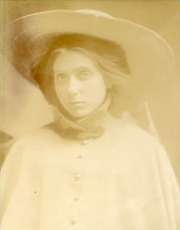
Beatrice Wood
1908 |

Beatrice Wood
1908 |
With political turmoil in Europe and the onset of World War I, her parents brought a reluctant Beatrice back to New York, where her mother did everything within her power to discourage her plans for a career on the New York stage. Despite this, Beatrice’s fluency in French led her to join the French National Repertory Theatre, where she played over sixty ingénue roles under the stage name “Mademoiselle Patricia” to save her family’s name and reputation.
“I wanted to go on the stage,” Beatrice later recalled. “Not because I was stage-struck, but to earn money so that I could get away from home. Because I was a good little girl. Nothing is more revolting.”
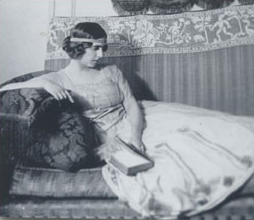
Beatrice Wood at her Parents' Home
New York, 1912
|
Becoming Bohemian
While working as an actress in New York City, a friend told Beatrice about a Frenchman who was in the hospital with a broken leg, who was very lonely and had no one to talk to. It turned out to be the composer Edgard Varèse, who introduced her to Marcel Duchamp on her next visit.
|
“…We immediately fell for each other,” Beatrice recalled of her meeting with Duchamp. “Which doesn't mean a thing because I think anybody who met Marcel fell for him. He was an enchanting person.”
Marcel Duchamp, who had risen to fame with paintings such as Nude Descending a Staircase and ultimately changed the course of modern art with his conceptual works, introduced Beatrice to Henri-Pierre Roché, a French diplomat, writer and art collector. Roché was to become her first lover, introducing her to the vibrant world of modern art and encouraging her own creative pursuits. He was also the first man to break her heart. Claiming to be a “monogamous woman in a polygamous world”, Beatrice had found herself surrounded by bohemian men who thought little of bourgeois morality.
“Marcel shocked me because he said that sex and love are two different things,” Beatrice later recalled. Yet, she fell into a relationship with him because she felt they should become, “as close physically as they were emotionally” and they remained life-long friends. |
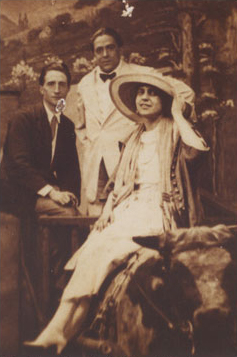
Beatrice Wood with Marcel Duchamp
and Francis Picabia
June 21, 1917 (Coney Island) |
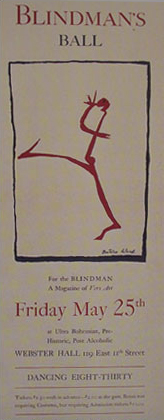
The Blindman's Ball Poster
Designed by Beatrice Wood, 1917 |
New York Dada
Marcel Duchamp brought Beatrice into the world of the New York Dada group, which existed by the patronage of art collectors Walter and Louise Arensberg. The Arensbergs’ home became the center of legendary soirees that included leading figures of the time including Francis Picabia, Mina Loy, Man Ray, Charles Demuth, Joseph Stella, Charles Sheeler and the composer Edgard Varèse.
Beatrice Wood’s career as an artist of note began when she created an abstraction to tease Duchamp that anyone could create modern art. Duchamp was impressed by the work, arranging to have it published in a magazine and inviting her to work in his studio. It was here that she developed her style of spontaneous sketching and painting that continued throughout her life.
Following the formation of the Society of Independent Artists in 1917, Beatrice exhibited work in their Independents exhibition. Although her work in the exhibition caused some amount of scandal, nothing could compare with the impact of Duchamp’s work – a manufactured urinal exhibited under the pseudonym R. Mutt. This work, photographed by Alfred Stieglitz and defended in an essay by Beatrice in the avant-garde journal The Blind Man, went on to become an icon of modern art. |
| Leaving New York
In 1918, Beatrice Wood ran off to Montreal to appear in the theatre there.
“Oh, I was terribly unhappy,” Beatrice later offered of her years in the theatre. “And my mother had interfered with every role offered me. So I left.”
Her mother hired a private detective who found that she was sharing an apartment in Montreal with Paul, the theatre manager and was horrified. Paul convinced Beatrice that the only way to escape her mother’s control was to marry him and she did so. It was a marriage that was without love, in which he sold her art books and borrowed money from her friends to support his gambling habit. The unconsummated marriage was legally dissolved years later by her parents. By this time, Beatrice had lost interest in the theatre.
“I was interested in the theatre as an art and, after a few years in it, gave it up,” Beatrice later said of leaving the theatre. “You know, acting is very fascinating. But being an actress is not, because you become so concentrated on yourself. And your smile and the way you move your head and the way you look. And really, it's a pain in the ass.”
Returning to New York City from Canada, Beatrice found that the Dada movement had dissipated. Roché had gone back to France, Duchamp had gone abroad and the Arensbergs had moved to Los Angeles. Beatrice fell in love with the British actor and director Reginald Pole and, although she fell for others over the next several decades, she claimed that she’d never stopped loving him. It was Pole who introduced her to Dr. Annie Besant of the Theosophical Society and the Indian sage Jiddu Krishnamurti. When Pole fell in love with a young girl and broke her heart, Beatrice moved to Los Angeles to be near the Arensbergs and Krishnamurti, who held regular events there. |
Page 1 | Page 2 | Page 3 |